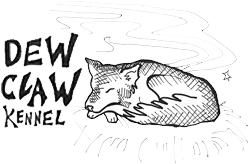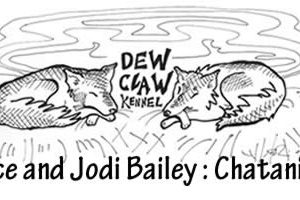Many have joked that it is the worst part of racing. In truth they may be right. Drop bags can make or break your race, and are sure to break the bank. Think about it: every item you will need, kibble you will feed, piece of clean clothing you have access to, and anything else you have thought of needs to be gathered together. Then it is counted or measured and organized to be packaged up and shipped out for your race. It is all done well before the race start and turned in at the assigned time. Once you have turned it over to race officials, they take over and ship your drop bags out to the various manned checkpoints along the trail. There they will be waiting for you and your team to arrive.
Did you pack everything? Really? Are you sure? Cause once you turn in the bags to be shipped out, that is all you get! (with the notable exception of the 36 hour layover in Dawson during the Yukon Quest, at which time you can resupply from your truck or local stores.)
Race rules give some guidance about drop bags. Actually race rules are important to an understanding of these long distance dog races, and are worth a read through for both mushers and fans.
Here are the Yukon Quest rules:
See page 2 for info on the checkpoints and drop bags.
And the Iditarod rules:
Food Drops and Logistics begins on page 14.
But the rules are only a part of what a musher needs to consider when preparing race drop bags. Racing sled dogs have an amazing aerobic capacity, are fueled by a high fat diet, and will eat as much as 12,000 calories a day. (read more here) You need to understand your team’s needs and make sure you have packed enough to be able to care for them, taking into account things rarely go as planned for an entire 1000 miles. You need to anticipate your needs for every section of trail and every checkpoint. I was very lucky that Dan had broken the trail for me, so to speak. I had helped him prepare drops for both the Quest and Iditarod. And in preparation for his first race he had handled on the Yukon Quest for another musher and had the opportunity to see first hand how things worked. If you do not happen to live with a race veteran there are actually audio files, if you are interested, from past Yukon Quest rookie meetings. The cover a variety of topics, but for the purpose of this blog may I suggest Gerry Willomitzer: Drop bags and how to pack them.
And now as the title promised “a photo dissection of what goes into planning for 1000 miles”.

Everything from booties to people food gets packed in freezer bags, these were decorated by school kids. They cheer me up when I am tired and are hard to loose in the snow.

People food and supplies are put in bags for each checkpoint. The little green bags in back are my new favorite, I found them this winter: caffeinated jelly beans!
Now we are ready to start tackling the most important part, the Dog Food.

Meat is cut into snack sized chunks, we will feed them as trail snacks during runs. We will also defrost them in hot water to add to meals and make drinks when we camp or at checkpoints.

Our dear friend and constant kennel help Joel, still smiling after days and days of drop bag preparation. He spent a lot of time at the meat saw that week.

Snacks are counted out and packed in bags. Kibble is measured for meals. We were very fortunate to have high quality meat products for the team from Bailey’s Farm. Their tripe is the best!

Meals and snacks are lined out by checkpoint. It is a good way to get an overview of how you have packed for your race. Thanks to International Plastics for the many bags we need!

Finally everything is laid out and ready to be packed in the labeled drop bags. In addition to everything you have already seen we also add sled runner plastic, and a few other incidentals and supplies needed for the long haul.
These photos were taken this winter as Dan and I got our Yukon Quest drop bags, and also as I did my Iditarod bags. The Iditarod bags were actually due to be turned in while I was out on the Yukon Quest trail. So mine needed to be done and stored in our walk in dog food freezer ready for a very trusted friend to turn in for me. We may be smiling in the photos but do not be fooled; this is actually a very serious and slightly stressful time. I can not emphasize enough how important it is to have well thought out, completely stocked drop bags.
To be honest even with all the times I had helped Dan with his drop bags, this year’s were a new and special kinda of stress for me. This time I was the one responsible, I was the one who would be depending on them. I had heard the term ‘rookie bulge’ before, the nervous over-packing that can weight down your sled. I tried to make careful choices when it came to what I actually carried in the sled. But the drop bags are shipped and you can send as much as you want. My drop bags definitely had a touch of the ‘rookie bulge’. But now having done the races I am glad for it, and plan on packing again this year with a ‘better safe then sorry’ philosophy.
Things I will be packing again for sure!
- Tanka Bars
- Meats from Bailey’s Farms
- Extreme Sport Beans with caffeine
- All organized and packed in Freezer Bags from International Plastics










